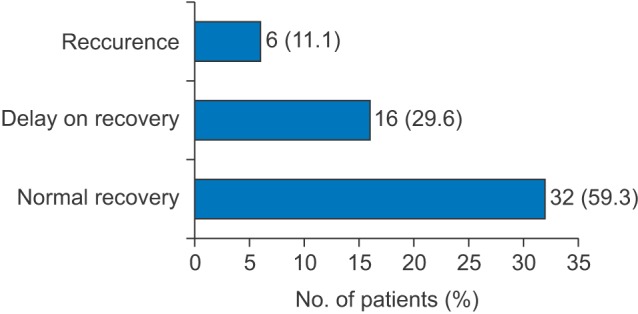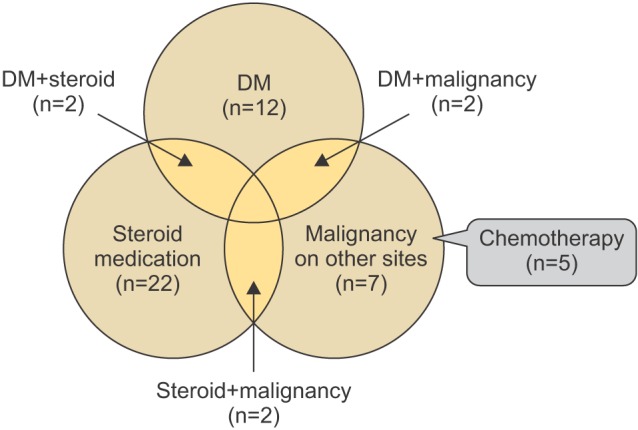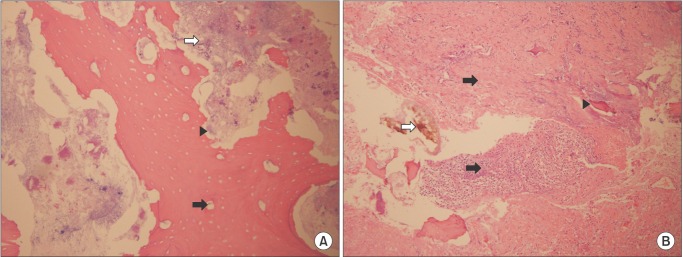J Korean Assoc Oral Maxillofac Surg.
2016 Aug;42(4):193-204. 10.5125/jkaoms.2016.42.4.193.
Evaluation of the predisposing factors and involved outcome of surgical treatment in bisphosphonate-related osteonecrosis of the jaw cases including bone biopsies
- Affiliations
-
- 1Department of Oral and Maxillofacial Surgery, College of Dentistry, Dankook University, Cheonan, Korea. lee201@dankook.ac.kr
- KMID: 2350071
- DOI: http://doi.org/10.5125/jkaoms.2016.42.4.193
Abstract
OBJECTIVES
This study examined the statistical relevance of whether the systemic predisposing factors affect the prognosis of surgical treatment of bisphosphonate-related osteonecrosis of the jaw (BRONJ). All cases had undergone bone biopsies to determine the characteristics of the mechanisms of BRONJ by optical microscopy.
MATERIALS AND METHODS
The data included 54 BRONJ cases who underwent surgery and in whom bone biopsies were performed. The results of surgery were evaluated and the results were classified into 3 categories: normal recovery, delayed recovery, and recurrence after surgery. The medical history, such as diabetes mellitus, medication of steroids, malignancies on other sites was investigated for an evaluation of the systemic predisposing factors in relation to the prognosis. The three factors involved with the medication of bisphosphonate (BP) were the medication route, medication period, and drug holiday of BP before surgery. The serum C-terminal cross-linking telopeptide (CTX) value and presence of microorganism colony in bone biopsy specimens were also checked. Statistical analysis was then carried out to determine the relationship between these factors and the results of surgery.
RESULTS
The group of patients suffering from diabetes and on steroids tended to show poorer results after surgery. Parenteral medication of BP made the patients have a poorer prognosis after surgery than oral medication. In contrast, the medication period and drug holiday of BP before surgery did not have significance with the results of surgery nor did the serum CTX value and presence of microorganism colony. Necrotic bone specimens in this study typically showed disappearing new bone formation around the osteocytic lacunae and destroyed Howship's lacunae.
CONCLUSION
Although many variables exist, this study could in part, predict the prognosis of surgical treatment of BRONJ by taking the patient's medical history.
Keyword
MeSH Terms
Figure
Cited by 2 articles
-
Risk factors of medication-related osteonecrosis of the jaw: a retrospective study in a Turkish subpopulation
Onur Şahin, Onur Odabaşı, Toghrul Aliyev, Birkan Tatar
J Korean Assoc Oral Maxillofac Surg. 2019;45(2):108-115. doi: 10.5125/jkaoms.2019.45.2.108.Clinical significance of drug cessation on medication-related osteonecrosis of the jaw in patients with osteoporosis
Kezia Rachellea Mustakim, Mi Young Eo, Ju Young Lee, Mi Hyun Seo, Soung Min Kim
J Korean Assoc Oral Maxillofac Surg. 2023;49(2):75-85. doi: 10.5125/jkaoms.2023.49.2.75.
Reference
-
1. McClung MR. Bisphosphonates. Endocrinol Metab Clin North Am. 2003; 32:253–271. PMID: 12699302.
Article2. Stanton DC, Balasanian E. Outcome of surgical management of bisphosphonate-related osteonecrosis of the jaws: review of 33 surgical cases. J Oral Maxillofac Surg. 2009; 67:943–950. PMID: 19375001.
Article3. Marx RE. Pamidronate (Aredia) and zoledronate (Zometa) induced avascular necrosis of the jaws: a growing epidemic. J Oral Maxillofac Surg. 2003; 61:1115–1117. PMID: 12966493.
Article4. Ruggiero SL, Mehrotra B, Rosenberg TJ, Engroff SL. Osteonecrosis of the jaws associated with the use of bisphosphonates: a review of 63 cases. J Oral Maxillofac Surg. 2004; 62:527–534. PMID: 15122554.
Article5. Hinson AM, Smith CW, Siegel ER, Stack BC Jr. Is bisphosphonate-related osteonecrosis of the jaw an infection? A histological and microbiological ten-year summary. Int J Dent. 2014; DOI: 10.1155/2014/452737.
Article6. Ohe JY, Kwon YD, Lee HW. Bisphosphonates modulate the expression of OPG and M-CSF in hMSC-derived osteoblasts. Clin Oral Investig. 2012; 16:1153–1159.
Article7. Kim RH, Lee RS, Williams D, Bae S, Woo J, Lieberman M, et al. Bisphosphonates induce senescence in normal human oral keratinocytes. J Dent Res. 2011; 90:810–816. PMID: 21427353.
Article8. Kos M, Brusco D, Kuebler J, Engelke W. Clinical comparison of patients with osteonecrosis of the jaws, with and without a history of bisphosphonates administration. Int J Oral Maxillofac Surg. 2010; 39:1097–1102. PMID: 20817480.
Article9. Lee SH, Chang SS, Lee M, Chan RC, Lee CC. Risk of osteonecrosis in patients taking bisphosphonates for prevention of osteoalsoRaporosis: a systematic review and meta-analysis. Osteoporos Int. 2014; 25:1131–1139. PMID: 24343364.10. Khamaisi M, Regev E, Yarom N, Avni B, Leitersdorf E, Raz I, et al. Possible association between diabetes and bisphosphonate-related jaw osteonecrosis. J Clin Endocrinol Metab. 2007; 92:1172–1175. PMID: 17179196.
Article11. Sung EC, Chan SM, Sakurai K, Chung E. Osteonecrosis of the maxilla as a complication to chemotherapy: a case report. Spec Care Dentist. 2002; 22:142–146. PMID: 12449457.
Article12. Tarassoff P, Csermak K. Avascular necrosis of the jaws: risk factors in metastatic cancer patients. J Oral Maxillofac Surg. 2003; 61:1238–1239. PMID: 14586868.
Article13. Migliorati CA, Schubert MM, Peterson DE, Seneda LM. Bisphosphonate-associated osteonecrosis of mandibular and maxillary bone: an emerging oral complication of supportive cancer therapy. Cancer. 2005; 104:83–93. PMID: 15929121.14. Hewitt C, Farah CS. Bisphosphonate-related osteonecrosis of the jaws: a comprehensive review. J Oral Pathol Med. 2007; 36:319–328. PMID: 17559492.
Article15. Leite AF, Figueiredo PT, Melo NS, Acevedo AC, Cavalcanti MG, Paula LM, et al. Bisphosphonate-associated osteonecrosis of the jaws. Report of a case and literature review. Oral Surg Oral Med Oral Pathol Oral Radiol Endod. 2006; 102:14–21. PMID: 16831667.
Article16. Marx RE, Cillo JE Jr, Ulloa JJ. Oral bisphosphonate-induced osteonecrosis: risk factors, prediction of risk using serum CTX testing, prevention, and treatment. J Oral Maxillofac Surg. 2007; 65:2397–2410. PMID: 18022461.
Article17. Freiberger JJ, Padilla-Burgos R, Chhoeu AH, Kraft KH, Boneta O, Moon RE, et al. Hyperbaric oxygen treatment and bisphosphonate-induced osteonecrosis of the jaw: a case series. J Oral Maxillofac Surg. 2007; 65:1321–1327. PMID: 17577496.
Article18. Vescovi P, Merigo E, Meleti M, Manfredi M. Bisphosphonate-associated osteonecrosis (BON) of the jaws: a possible treatment? J Oral Maxillofac Surg. 2006; 64:1460–1462. PMID: 16916694.
Article19. Lopes RN, Rabelo GD, Rocha AC, Carvalho PA, Alves FA. Surgical therapy for bisphosphonate-related osteonecrosis of the jaw: six-year experience of a single institution. J Oral Maxillofac Surg. 2015; 73:1288–1295. PMID: 25871903.
Article20. Stockmann P, Burger M, von Wilmowsky C, Ebker T, Lutz R, Bauersachs A, et al. The outcome after surgical therapy of bisphosphonate-associated osteonecrosis of the jaw--results of a clinical case series with an average follow-up of 20 months. Clin Oral Investig. 2014; 18:1299–1304.21. Carlson ER, Basile JD. The role of surgical resection in the management of bisphosphonate-related osteonecrosis of the jaws. J Oral Maxillofac Surg. 2009; 67(5 Suppl):85–95. PMID: 19371819.
Article22. Reich W, Bilkenroth U, Schubert J, Wickenhauser C, Eckert AW. Surgical treatment of bisphosphonate-associated osteonecrosis: Prognostic score and long-term results. J Craniomaxillofac Surg. 2015; 43:1809–1822. PMID: 26321065.
Article23. Kim KW, Kim BJ, Lee CH. Clinical study of diagnosis and treatment of bisphosphonate-related osteonecrosis of the jaws. J Korean Assoc Oral Maxillofac Surg. 2011; 37:54–61.
Article24. Lehenkari PP, Kellinsalmi M, Näpänkangas JP, Ylitalo KV, Mönkkönen J, Rogers MJ, et al. Further insight into mechanism of action of clodronate: inhibition of mitochondrial ADP/ATP translocase by a nonhydrolyzable, adenine-containing metabolite. Mol Pharmacol. 2002; 61:1255–1262. PMID: 11961144.
Article25. Molcho S, Peer A, Berg T, Futerman B, Khamaisi M. Diabetes microvascular disease and the risk for bisphosphonate-related osteonecrosis of the jaw: a single center study. J Clin Endocrinol Metab. 2013; 98:E1807–E1812. PMID: 24037883.
Article26. Watters AL, Hansen HJ, Williams T, Chou JF, Riedel E, Halpern J, et al. Intravenous bisphosphonate-related osteonecrosis of the jaw: long-term follow-up of 109 patients. Oral Surg Oral Med Oral Pathol Oral Radiol. 2013; 115:192–200. PMID: 23036797.
Article27. Favus MJ. Diabetes and the risk of osteonecrosis of the jaw. J Clin Endocrinol Metab. 2007; 92:817–818. PMID: 17341579.
Article28. Ichiseki T, Ueda Y, Katsuda S, Kitamura K, Kaneuji A, Matsumoto T. Oxidative stress by glutathione depletion induces osteonecrosis in rats. Rheumatology (Oxford). 2006; 45:287–290. PMID: 16303823.
Article29. Ortega C, Montemurro F, Faggiuolo R, Vormola R, Nanni D, Goia F, et al. Osteonecrosis of the jaw in prostate cancer patients with bone metastases treated with zoledronate: a retrospective analysis. Acta Oncol. 2007; 46:664–668. PMID: 17562443.
Article30. Vieillard MH, Maes JM, Penel G, Facon T, Magro L, Bonneterre J, et al. Thirteen cases of jaw osteonecrosis in patients on bisphosphonate therapy. Joint Bone Spine. 2008; 75:34–40. PMID: 17981488.
Article31. Kos M, Kuebler JF, Luczak K, Engelke W. Bisphosphonate-related osteonecrosis of the jaws: a review of 34 cases and evaluation of risk. J Craniomaxillofac Surg. 2010; 38:255–259. PMID: 19592261.
Article32. Brown JE, Cook RJ, Major P, Lipton A, Saad F, Smith M, et al. Bone turnover markers as predictors of skeletal complications in prostate cancer, lung cancer, and other solid tumors. J Natl Cancer Inst. 2005; 97:59–69. PMID: 15632381.
Article33. Garnero P, Delmas PD. Noninvasive techniques for assessing skeletal changes in inflammatory arthritis: bone biomarkers. Curr Opin Rheumatol. 2004; 16:428–434. PMID: 15201607.34. Fleisher KE, Welch G, Kottal S, Craig RG, Saxena D, Glickman RS. Predicting risk for bisphosphonate-related osteonecrosis of the jaws: CTX versus radiographic markers. Oral Surg Oral Med Oral Pathol Oral Radiol Endod. 2010; 110:509–516. PMID: 20674404.
Article35. Kunchur R, Need A, Hughes T, Goss A. Clinical investigation of C-terminal cross-linking telopeptide test in prevention and management of bisphosphonate-associated osteonecrosis of the jaws. J Oral Maxillofac Surg. 2009; 67:1167–1173. PMID: 19446200.
Article36. American Society for Bone and Mineral Research Task Force on Osteonecrosis of the Jaw. Khosla S, Burr D, Cauley J, Dempster DW, Ebeling PR, et al. Oral bisphosphonate-induced osteonecrosis: risk factors, prediction of risk using serum CTX testing, prevention, and treatment. J Oral Maxillofac Surg. 2008; 66:1320–1321. author reply 1321-2. PMID: 18486811.
Article37. Berger CE, Kröner A, Kristen KH, Minai-Pour M, Leitha T, Engel A. Spontaneous osteonecrosis of the knee: biochemical markers of bone turnover and pathohistology. Osteoarthritis Cartilage. 2005; 13:716–721. PMID: 15922633.
Article38. Ganguli A, Steward C, Butler SL, Philips GJ, Meikle ST, Lloyd AW, et al. Bacterial adhesion to bisphosphonate coated hydroxyapatite. J Mater Sci Mater Med. 2005; 16:283–287. PMID: 15803271.
Article39. Kos M, Junka A, Smutnicka D, Bartoszewicz M, Kurzynowski T, Gluza K. Pamidronate enhances bacterial adhesion to bone hydroxyapatite. Another puzzle in the pathology of bisphosphonate-related osteonecrosis of the jaw? J Oral Maxillofac Surg. 2013; 71:1010–1016. PMID: 23489958.
Article40. Anavi-Lev K, Anavi Y, Chaushu G, Alon DM, Gal G, Kaplan I. Bisphosphonate related osteonecrosis of the jaws: clinico-pathological investigation and histomorphometric analysis. Oral Surg Oral Med Oral Pathol Oral Radiol. 2013; 115:660–666. PMID: 23601221.
Article41. Hansen T, Kunkel M, Springer E, Walter C, Weber A, Siegel E, et al. Actinomycosis of the jaws--histopathological study of 45 patients shows significant involvement in bisphosphonate-associated osteonecrosis and infected osteoradionecrosis. Virchows Arch. 2007; 451:1009–1017. PMID: 17952459.
Article42. Naik NH, Russo TA. Bisphosphonate-related osteonecrosis of the jaw: the role of actinomyces. Clin Infect Dis. 2009; 49:1729–1732. PMID: 19886792.
Article43. Kumar SK, Gorur A, Schaudinn C, Shuler CF, Costerton JW, Sedghizadeh PP. The role of microbial biofilms in osteonecrosis of the jaw associated with bisphosphonate therapy. Curr Osteoporos Rep. 2010; 8:40–48. PMID: 20425090.
Article44. Sedghizadeh PP, Yooseph S, Fadrosh DW, Zeigler-Allen L, Thiagarajan M, Salek H, et al. Metagenomic investigation of microbes and viruses in patients with jaw osteonecrosis associated with bisphosphonate therapy. Oral Surg Oral Med Oral Pathol Oral Radiol. 2012; 114:764–770. PMID: 23159114.
Article
- Full Text Links
- Actions
-
Cited
- CITED
-
- Close
- Share
- Similar articles
-
- Bisphosphonate-Related Osteonecrosis in a Patient with Florid Cemento-Osseous Dysplasia
- Clinical feature and treatment of bisphosphonate-related osteonecrosis of jaw about oral bisphosphonate administrated patients: case reports
- A Case of Sinusitis due to Bisphosphonate Related Osteonecrosis of Jaw
- A Case of Intractable Bisphosphonate-Related Osteonecrosis of the Jaw Treated with Teriparatide
- Dental implant treatment after healing of bisphosphonate-related osteonecrosis of the jaw (BRONJ) in the same region: a case report






